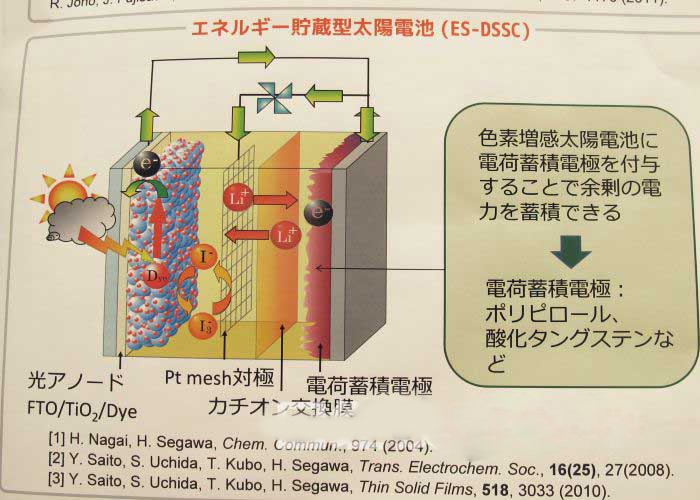Stained glass that generates discoloration and generates electricity using dye-sensitized dye storage
 |
Two "Annabelle" trim panels (left) and one decorative light fixture "Pattern/Hikari" (right). The rechargeable battery is installed in the hydrangeas part of the pattern, and the color changes from white to dark blue depending on the charging condition.

The structure of ES-DSSC developed by the Tokyo University's Chuangawa Research Office. The structure used in this exhibition is slightly different.
In collaboration with Sony, the laboratory of Prof. Sasagawa Hiroshi of the University of Tokyo’s Advanced Science and Technology Research Center co-produced a decorative panel and a decorative luminaire with the power generation and storage function, and also changed color, such as stained glass, and was exhibited at the Japan PV Show “PVJapan2014. "Exhibited on the show.
All exhibits are based on a hydrangea-based design. Looks like a stained glass named "Annabelle" (Bella Anna), named after a white hydrangea variety. The decorative light fixture is named "Pattern/Hikari". The fixture will generate electricity while lighting, and the generated power can be exported through the USB interface.
These exhibits use the energy-storage dye-sensitized solar cells "ES-DSSC (energy-storage dye-sensitized solar cells)" previously developed by the Seikawa Research Laboratory and were manufactured in cooperation with Sony. ES-DSSC is a solar cell researched by the Sasakawa Laboratory from around 2003. The initial design plan was to laminate a secondary battery on the back side of a dye-sensitized solar cell (DSSC). Both the electrode and the electrolyte of the DSSC were used. Share with secondary battery.
This time, the DSSC and the secondary battery were arranged in the horizontal direction rather than in the vertically overlapping structure. The DSSC and the secondary battery are arranged in different colors of the colored glass.
DSSC has high design features at the beginning of development and can change the color of panels by selecting pigments. This time, the secondary battery also has a decorative effect, which utilizes the feature that the color of the secondary battery will change with the change in the state of charge.
The reason why the color of the secondary battery changes is that tungsten oxide (WOx) is used as the charge collector. WOx has "electrochromic" properties, and when charges accumulate, the color changes from transparent to dark blue.
The display panels and decorative lights on the show were equipped with DSSCs in the hydrangea leaves and other parts, and secondary batteries were placed on the flowers. The secondary battery is basically white in the discharged state, but as the battery is charged, the color gradually turns dark blue, which is very suitable for expressing the hydrangeas whose color gradually changes during flowering. (Reporter: Nozawa Tetsuru, Nikkei Electronics)
Dye was able to make sure the color attached to the fiber material, and easy to fall off, change color. Typically dye dissolved in water, a part of the dye Mordant dye can require adhesion to the fibers. Archaeological data show that staining technique in India and the Middle East for over five thousand years of history. Then dyes or minerals come from plants and animals, rarely treated.
Dyes are usually applied in an aqueous solution, and may require a mordant to improve the fastness of the dye on the fiber.
Dyes
Natural Dyes, Fabric Dyes, Reactive Dyes
Dynasty Chemicals (NingBo) Co., Ltd. , https://www.dychemco.com